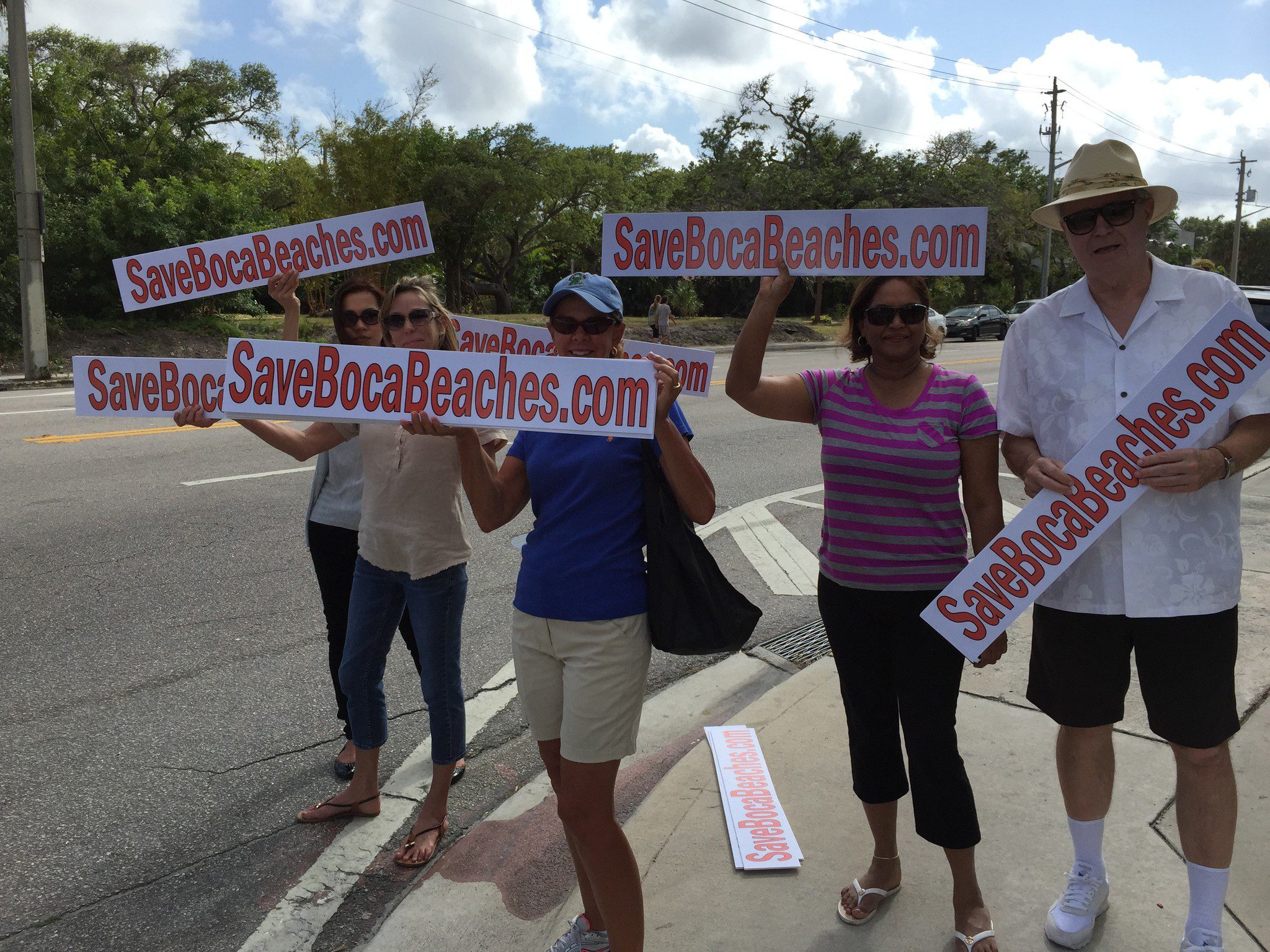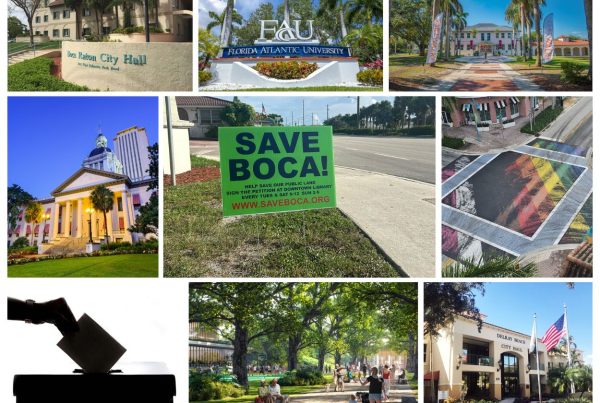
The Chabad discussion
At 10:30 Wednesday night, many of the people in the Boca Raton City Council chambers were ready to kiss Councilman Mike Mullaugh.
The council was four-plus hours into a hearing on the Chabad East Boca project. Speaker after speaker on both sides had said pretty much the same thing over and over—sometimes after beginning by saying that he or she agreed with what someone else had said. To steal from a review of the 1959 movie “Ben-Hur,” it was like being stuck at a railroad crossing while a long freight train trundled past. City staffers were fading. The three police officers were fading. You could see which way the vote was going to go. Finish it.
After that interminable public comment period and a short break, Mayor Susan Haynie called for council comment on a motion to approve the added height—from 30 feet to 40 feet—for one part of the project, which will include a synagogue, a museum and a social hall. Mullaugh said, “I have heard no testimony, let alone evidence, that (the extra height) will injure” the surrounding neighborhoods on East Palmetto Park Road. Mullaugh pronounced himself ready to vote for approval. He had it right. Even better, he had it right in about 30 seconds.
The council got there, voting 4-1 in favor—Jeremy Rodgers dissenting—but not before almost another hour had passed. Not before the council had attached more, mostly symbolic conditions to many conditions already attached to the approval. Not before more tortured discussion of legal fine points. Not before the council—mainly Scott Singer—tried to assure the often-unreasonable opponents that while council members understood their objections, the zoning rules gave them little choice.
Naturally, given this drawn-out drama, Wednesday night’s decision likely isn’t the last one. As discussion started, City Attorney Diana Grub Frieser informed the council that the opponents—residents of the Riviera and Por La Mar neighborhoods—had appealed the Planning and Zoning Board’s May 7 approval of Chabad East Boca’s site plan. If the city determines that the appeal is reasonable, the site plan will go before the council, probably in July. You can assume that the city will find the appeal reasonable, if only to show that the city gave the opponents every possible chance.
According to long-timers at City Hall, even such emotional issues as Boca Teeca in 2007—still unresolved—and Ocean Strand didn’t bring out the crowds Chabad East Boca has. For the congregation, there’s history here.
Seeking a larger facility than the current one near Sanborn Square, the chabad first considered a site on Mizner Boulevard between St. Gregory’s Episcopal Church and First United Methodist Church. But neighbors in the Golden Triangle objected, and the council thwarted the chabad with new rules on parking.
So now the congregation wants to build where the rules allow places of worship and allow the extra height under conditions to which Chabad East Boca has agreed. Rabbi Ruvi New, the congregation’s leader, referenced anti-Semitism only indirectly when he addressed the Planning and Zoning Board. Speaking to Boca Raton’s elected leaders, he was far less subtle.
“At the dawn of time itself,” New began, using the story of Cain and Abel to illustrate the concept of “not in my backyard.” It was that kind of night.
In 2008, New said, the cry had been “Save Our Neighborhood. From what?” New, of course, was asking rhetorically. In 2015, the rabbi continued, the cry is “Save Boca Beaches,” referring to the opponents’ website. “We are deeply offended by the notion that this city needs to be saved from what it is we will bring.”
One critic, New recalled, objected because Boca Raton needs to look more like Aspen. New produced a slide of the new Aspen Chabad, which is about 22,000 square feet larger than what Chabad East Boca proposes. “We are sick and tired of being kicked around,” New told the council. “The law must prevail.”
Then the opponents started in, and many of them made the chabad’s case by how badly they made theirs.
Under city rules, the applicant and the organized opposition had 20 minutes to make their cases. One neighborhood leader wasted almost 10 of his 20 minutes arguing for 30 minutes. (His side eventually did get extra time.) He argued that the council should postpone its vote because the opponents hadn’t been aware that Wednesday was a vote only the height. Yet the council had delayed its vote by several weeks already, after opponents raised a technical point the first time around.
Critics said the council had “ignored your own ordinances” and “turned a blind eye to the code.” Wrong on both counts. Another said “the legacy” of Boca Raton’s “pristine beaches has been passed to you.” How does a place of worship threaten the beach? Another said the project had been “cloaked in secrecy.” Right. At multiple public hearings. Still another said approval would turn the beach district into “another Miami Beach.” Then there was the opponent who said he could understand why Chabad East Boca wanted to expand, since Boca Raton “is 50 percent Jewish.” Later came the guy who advised everyone that despite his long beard, he isn’t Jewish. “More of a ZZ Top look.” He backed the project.
The key point actually had come early, when City Traffic Engineer Doug Hess said the additional 10 feet for the museum/exhibit hall would have no effect on traffic. His testimony undercut all the complaints about traffic, some of which had nothing to do with the chabad and which were not at issue before the council. Nevertheless, Rabbi New agreed that he wouldn’t try to add a nosebleed section that might draw a few more visitors.
The only credible point from the opponents was that while Boca Raton has granted added height to other houses of worship, they are on larger sites. Chabad East Boca wants to build on 0.8 acres. But that’s also why the approval comes with so many conditions.
You could tell that the opponents are preparing for a lawsuit. They trotted out a lawyer, a planner and a traffic engineer. They had court reporters. Since the city code prohibits the added height unless it is “injurious” to the area, opponents spoke of “injury” and “being injured.”
If Chabad East Boca loses, however, the congregation most definitely will sue. Boca Raton’s legal position will be much stronger if it is defending a lawsuit from the opponents, not Chabad East Boca.
And that long winded problem
As Wednesday night’s hearing showed, Boca Raton should change its rules on public comment.
The city allows speakers a generous five minutes. Many other cities allow three minutes. The added time might not seem like much, but when 50 speakers show up, you’ve added 100 minutes of comment—without adding any content to the debate.
If people can’t make their point in three minutes, the point isn’t worth making. Abraham Lincoln made a lasting point at Gettysburg in 1863, and he did so in less than three minutes. Despite what some speakers believe, telling the council that they’ve lived in Boca for 40 years or run a business up North doesn’t give them any more standing. As noted, any organized opposition gets 20 minutes to make its case. Assume that the council members are judges. Good lawyers know that concise arguments beat long-winded arguments. Democracy in Boca Raton won’t suffer if speakers have three-minute limits.
Boca Watch
Al Zucaro, who operates the Boca Watch blog, has filed ethics complaints against Deputy City Manager George Brown and Councilman Robert Weinroth after the city council appointed them this month to the board of the Boca Raton Airport Authority.
Zucaro notified the city of the complaints to the Florida Commission on Ethics. He appeared at Wednesday night’s council meeting to argue that Brown and Weinroth should pay for their own legal defense. At the recommendation of City Attorney Diana Grub Frieser, the council correctly hired a law firm to represent Brown and Weinroth. I’ve never known of a city that didn’t pay the legal fees in such cases when the charges are related to the work of elected and unelected officials. Otherwise, critics could bleed them with such charges.
The appointments, though, continue to generate controversy as a policy move. I will have more next week.
Auburn Trace update
According to Mayor Cary Glickstein, Delray Beach remains on track to close Friday on the purchase of the first mortgage for the Auburn Trace housing project.
The developer, Auburn Trace Ltd., is in Chapter 11 bankruptcy proceedings. The city holds the second mortgage, having given up its first position years ago. That was a mistake by a previous commission; the developer wanted to obtain more financing. Delray gave Auburn Trace a nearly $4 million loan in 1988. Payments stopped a long time back. With interest and principal, the loan is worth about $4.5 million.
By purchasing the first mortgage from Iberiabank, which has foreclosed on the property, Delray can better protect its investment and can try to find a new company to take over and manage Auburn Trace, which needs improvements. The city, Glickstein said, “will begin marketing in earnest after the closing.”
Special session
The Florida Legislature will come back in special session starting Monday. Though the main issue is the budget— they ended the regular session early without passing one— the issue driving the budget is health care.
The Senate wants to expand Medicaid, Florida-style, and cover another 800,000-plus Floridians in addition to the 1.6 million who have obtained coverage through the Affordable Care Act. Gov. Rick Scott and the House oppose that plan. Everyone, though, worries about how much federal money Florida will receive for the 2016 fiscal year—it begins July 1—for coverage of the state’s uninsured population. To agree on a budget, the House and Senate must agree on that number.
Getting health coverage for more Floridians would help the state. So would having healthier Floridians, since they would need less medical care. Some new reports look at both topics.
Gallup Healthways just released its latest report on America and obesity. Not surprisingly, the survey ranked Hawaii and Colorado as having the lowest rates of obese people, which the organization defines as someone with a Body Mass Index of 30 or above. In Hawaii, they’re all surfing. In Colorado, they’re all rock-climbing.
Florida ranked 15th lowest, which I found encouraging until I read that New Jersey—where the porcine Chris Christie is governor—ranked 16th. Still, we’re a long way from the perpetual bottom-dwelling Arkansas, Louisiana, West Virginia and Mississippi. South Florida—Palm Beach, Broward and Miami-Dade counties—did even better, ranking 15-lowest among 100 metropolitan areas. The Sarasota-Bradenton area ranked eighth, with Fort Myers-Cape Coral ranking ninth.
The rankings matter because obesity leads to so many other health problems, notably diabetes. Nationally, Gallup Healthways found, obesity is at a record high—27.4 percent. The Brookings Institution recently calculated that if all the Americans under 18 who are obese now stay that way, the cost to society could be $1.1 trillion. Florida parents, get your kids off their smart phones—at least for a couple of hours.
••••••••
You can email Randy Schultz at randy@bocamag.com
For more City Watch blogs, click here.About the Author
Randy Schultz was born in Hartford, Conn., and graduated from the University of Tennessee in 1974. He has lived in South Florida since then, and in Boca Raton since 1985. Schultz spent nearly 40 years in daily journalism at the Miami Herald and Palm Beach Post, most recently as editorial page editor at the Post. His wife, Shelley, is director of The Learning Network at Pine Crest School. His son, an attorney, and daughter-in-law and three grandchildren also live in Boca Raton. His daughter is a veterinarian who lives in Baltimore.







